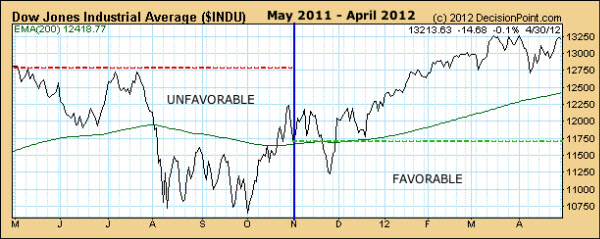- From May 1 through October 31 seasonality is unfavorable, and the market most often finishes lower than it was at the beginning of the period.
- The period from November 1 through April 30 is seasonally favorable, and the market most often finishes the period higher. (See Sy Harding's book, Riding the Bear, for an indepth discussion of this subject.)
While the statistical average results for these two periods are quite compelling, trying to ride the market in real-time in hopes of capturing these results is not always as easy as it sounds.
Below is the one-year chart that that shows the most recent two six-month periods. It begins on May 1, 2011 and ends on April 30, 2012.
via Carl Swenlin
The left half of the chart shows the unfavorable May through October period and the right half shows the favorable November through April period. The green line marks the beginning of the favorable period, the red line marks the beginning of the unfavorable period.
As you can see, the last two seasonality periods turned in textbook performance, with the unfavorable period closing lower, and the favorable period closing higher. However, every year is different and presents its own challenges … and there is no guarantee that any given period will conform to the average.
In addition, Swenlin asserts that bull and bear market pressures override seasonal tendencies more often than not.
With the election coming, we'll see whether things look better moving into the end of October.


